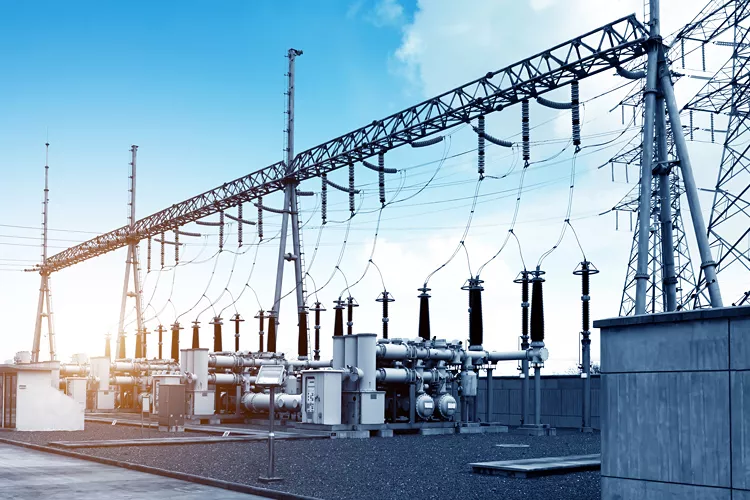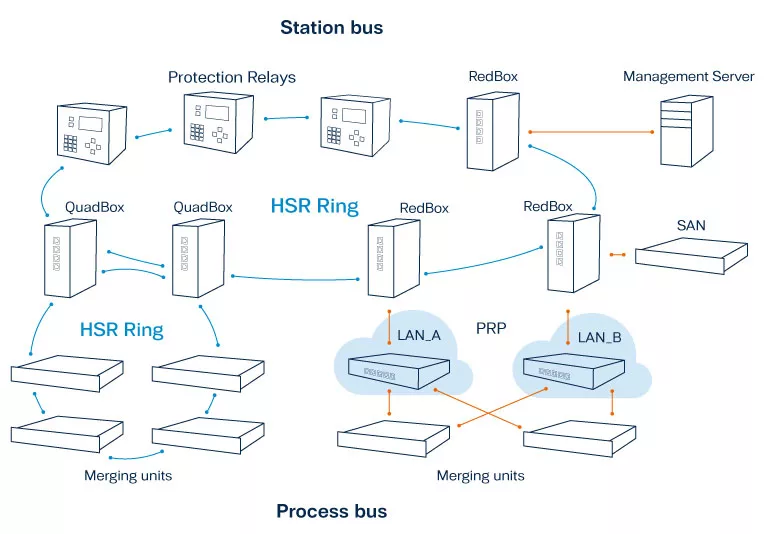Introduction
Today’s energy market faces growing demands that can only be met with highly efficient and reliable networks. As electricity networks are modernized and connected to renewable power sources like wind turbines and solar panels, they are required to handle multiple energy feed-in points, creating more complex distribution systems. Smart grid architectures are designed to better cope with these new challenges and to offer improved management of the power network that leads to cost and energy savings. A defining feature is increased automation, which enables remote services, repairs and voltage measurement. In order to deliver this functionality, smart grids require real-time monitoring and controlling as well as high-reliability to ensure a stable energy supply. For this reason, network redundancy is of paramount importance in smart grids.

What is network redundancy?
Network redundancy refers to the duplication of critical components or functions. Fail-safe, redundant systems are able to continue functioning in failure scenarios. This avoids data loss or danger to lives and property, while also decreasing network downtimes. An additional benefit is the option of performing maintenance while the network is up and running.
Ethernet, as a standard network protocol, is widely used and readily available to send data in networks. However, it is not inherently fault-tolerant. The addition of redundancy protocols takes care of this issue and thus enables the use of Ethernet as a network for smart grids. The Parallel Redundancy Protocol (PRP) and the High-availability Seamless Redundancy (HSR) protocol are defined in the IEC 62439-3 standard and are used to implement zero-loss redundancy on wired Ethernet.
What is the Parallel Redundancy Protocol (PRP)?
The Parallel Redundancy Protocol (PRP) is an IEC standard (IEC 62439-3 Clause 4) that provides redundant Ethernet. Under PRP, each node is connected to two separate parallel Local Area Networks (LANs). Source nodes send two copies of each packet, one over each network. When a destination node receives a packet, it accepts the first copy and discards the second copy, eliminating the duplicate.
The two networks are assumed to be fail-independent. The destination node will always receive at least one packet, as long as either one of the two networks is operational. This provides zero-time recovery in case of a single failure, so no frames are lost.
The downside of PRP is that the network cost is double when comparing with a single non-redundant network. This makes it more expensive to implement than other redundancy protocols. A High-availability Seamless Redundancy (HSR) ring provides the same level of redundancy as PRP, but at a lower cost. The advantage of PRP compared to HSR is that normal non-PRP aware nodes can be connected to the network without a RedBox. However, these singly attached nodes can communicate only with the nodes connected into the same LAN, and they do not benefit from the redundancy.
What is the High-availability Seamless Redundancy (HSR) protocol?
High-availability Seamless Redundancy (HSR) is a standard (IEC 62439-3 Clause 5) that provides redundant Ethernet. It is suitable for applications that require short reaction times and high availability. HSR can be used to build very robust networks with zero reaction time in case of a single failure, and predictable latency, at lower cost than other Ethernet redundancy solutions.
Many critical applications require a network with zero downtime. HSR allows a network to remain fully operational even during maintenance, as any device can be disconnected and replaced without breaking the network connectivity.
The typical HSR topology is a ring. The source node duplicates all the frames it has to send and sends them using two different paths to their destination. If either one of the paths is broken, due to link or node failure, the frames are still able to reach their destination.
Typically, HSR rings consist of three kinds of nodes:
- End nodes
- RedBoxes
- QuadBoxes

End nodes have two external Ethernet ports to connect to one HSR ring. They may also have one or more additional Ethernet ports, for example for maintenance access. When sending frames, an end node sends two duplicates of each frame into the network, one to each of the directions in the ring. When receiving, end nodes accept the first copy and discard the second, thus eliminating the duplicate. Sensors such as IEDs (Intelligent Electronic Devices), cameras, and merging units in substation automation are examples of end nodes.
RedBox (or Redundancy Box) is an entity that has three external Ethernet ports. Two of the ports are connected to an HSR ring and one is a traditional Ethernet port. RedBoxes are used to connect non-HSR nodes and non-HSR network segments to HSR rings, for example, ordinary Ethernet switches and computers. When forwarding frames to the ring, RedBox duplicates each frame and sends the two duplicates to the ring, one in each direction. When forwarding frames from the ring, RedBox forwards the first copy and discards the copy that arrives later.
QuadBox or Quadruple Port Device is a device connecting two HSR rings to each other. As one QuadBox would itself be a single point of failure, two adjacent QuadBoxes are typically used between HSR rings.
HSR rings are currently the most effective high-availability Ethernet method. HSR is similar to PRP in sending duplicate packets, however, unlike in PRP, there is no need for duplicate cables or switches in ring topology. This makes HSR rings a lot more cost effective than the two local area networks of PRP. Compared with Rapid Spanning Tree Protocol (RSTP), the benefit of HSR is its zero-time recovery – a single network fault in the ring will not result in any frame loss; the recovery times of RSTP are simply not acceptable in all applications.
Applications of HSR/PRP technology
HSR and PRP allow adding redundancy to standard Ethernet networks, thus making critical networks such as power supply safer and ensuring 24/7 availability and limited downtimes.
Flexibilis Redundant Switch (FRS) is TTTech Industrial’s HSR implementation. One of its special features is that no separate RedBoxes are needed. Non-HSR nodes and segments can be connected straight to the HSR nodes and rings. Although a simple ring is the typical topology for HSR, it is not the only possible one. Other alternatives include, for example, Virtual QuadBox, ShortCut Box, ShortBox and HSR Mesh. All these can be implemented with FRS.